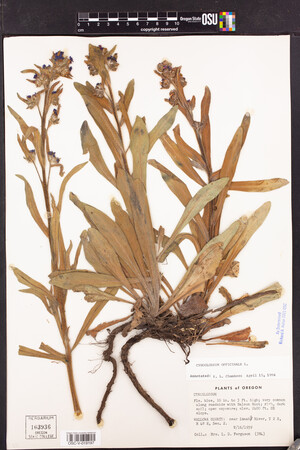Cynoglossum officinale
|
|
|
|
Family: Boraginaceae
Hound's-Tongue, more...Gypsy-Flower, common houndstongue, houndstongue
|
Biennial herb 30 cm - 1.2 m tall Stem: single (though inflorescence much branched), robust, leafy the entire length, and covered with short or long, soft hairs. Leaves: numerous, alternate, soft-hairy, non-toothed, but often wavy-edged, of two kinds: lower leaves stalked, relatively large (10 - 30 cm long, 2 - 5 cm wide), and narrowly elliptic or inversely lance-shaped; upper leaves smaller (though over 1 cm wide), more oblong or lance-shaped with a rounded base, and often with some tissue continuing down stem (decurrent). Inflorescence: of numerous, terminal or axillary (from leaf-like bracts), elongate branches with alternate flowers on curved, spreading stalks. Flowers: dull red or maroon, turning purplish with age, up to 1 cm tall, about 1 cm wide, radially symmetric, short tube-like with broad, spreading lobes, but center closed by arch-like raised folds (fornices) alternating petal lobes. Sepals: five, downy-hairy, 4 - 6.5 mm long (but less than three times longer than wide), oblong, with blunt or rounded tips. Petals: maroon to purplish, five, but fused for about half their length into a short tube (about same length as sepals) with prominent, arch-like raised folds (fornices) between the bases of the separate (though often overlapping), broad, rounded lobes. Stamens: five, attached to petal tube, but anthers not extending beyond the petal tube. Pistil: with one, deeply four-lobed, superior ovary; one style, which is longer than the nutlets; and one stigma. Fruit: a cluster of four, 5.5 - 8 mm tall, prickly hooked-hairy, egg-shaped nutlets with flattened outer sides edged by a raised rim. The tops of the four nutlets are attached to the base of the obvious remnant pointed style, and remain as a single cluster, which falls away from the base of the other remnant flower parts. Root: a very stout taproot. Similar species: Cynoglossum officinale is similar to Anchusa officinalis, except that species has the stem and leaves covered with harsh, stiff, and bristly hairs; the inflorescence is more obviously terminal and more compact; and the shorter nutlets are not prickly, but rounded on the outside, and have a thickened rim around their bases. This species of Cynoglossum may also be confused with C. virginianum var. boreale, however that species is smaller overall, it has fewer leaves, the inflorescence terminates the stem and has fewer branches, the flowers are blue, the petal lobes do not overlap, and the nutlets are smaller, rounded on all sides, and the style is not visible since it is shorter than the nutlets. Flowering: May to July Habitat and ecology: Native to Eurasia, weedy and often found in pastures, fields, and barnyards. Occurence in the Chicago region: non-native Notes: The prickly hairs on the fruit allow the nutlet clusters to attach (like Velcro balls) to the fur of animals and clothes of humans. This is probably one reason the plant is so common in pastures and barnyards. It is also reported that the plant has a "mousy" odor. Author: The Field Museum Coarse, single-stemmed biennial 3-12 dm, leafy to the top, villous or villous-hirsute; lowest lvs oblanceolate or narrowly elliptic, 1-3 dm overall, 2-5 cm wide, the others sessile and more oblong or lanceolate, numerous, gradually reduced; infl of numerous false racemes in the upper axils or on short axillary branches, the mature pedicels curved-spreading; cal at anthesis 3-5 mm; cor dull reddish-purple, nearly salverform, the limb 1 cm wide or a little less, the fornices exsert; nutlets 5-7 mm, ovate, descending-spreading, forming a broadly low-pyramidal fr, remaining attached to the style after splitting from the gynobase, the dorsal surface flattened, surrounded by a raised margin; 2n=24. Native of Eurasia, established as a weed in fields, meadows, and open woods throughout our range and westward. Gleason, Henry A. & Cronquist, Arthur J. 1991. Manual of vascular plants of northeastern United States and adjacent Canada. lxxv + 910 pp. ©The New York Botanical Garden. All rights reserved. Used by permission. From Flora of Indiana (1940) by Charles C. Deam More or less frequent in dry soil in pasture fields and woods pastures, on open wooded slopes, and along roadsides and railroads. This is a species that one usually, by preference, neglects to collect, and this fact, no doubt, accounts for the lack of specimens from the southwestern part of the state. There are specimens with white flowers from Kosciusko and Noble Counties. |
|
|
|





















































































